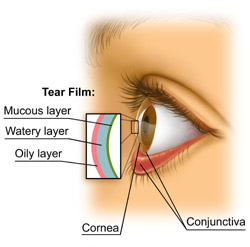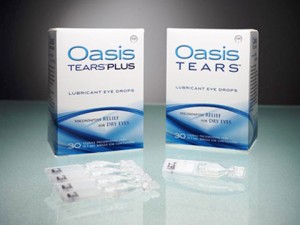Winter winds and moisture zapping heaters can cause dry, red and irritated eyes.
Tears are essential for good eye health and clear vision. They bathe the eye, washing out dust and debris, and keep the surface moist and clear. The natural tear film also contains enzymes that neutralize microorganisms, reducing the risk of eye infections.
 The most common signs and symptoms of dry eyes are persistent dryness and irritation, scratchiness, a burning feeling in your eyes and red eyes. Oddly enough, dry eye syndrome also can make your eyes watery, as dryness can cause a protective overproduction of the watery component of your tears.
The most common signs and symptoms of dry eyes are persistent dryness and irritation, scratchiness, a burning feeling in your eyes and red eyes. Oddly enough, dry eye syndrome also can make your eyes watery, as dryness can cause a protective overproduction of the watery component of your tears.
How to prevent dry eyes in winter
Cold winter wind outdoors and dry heat indoors can cause or worsen dry eyes. Follow these tips to keep dry eyes at bay.
- Wear sunglasses or goggles. Wearing close-fitting sunglasses outdoors reduces exposure to sun and wind that can dry out your eyes. If it’s especially cold and windy, try foam-lined goggles that provide even greater protection from tear evaporation.
- Supplement your diet. Fish oil and other nutritional supplements containing omega-3 fatty acids can help prevent or relieve dry eye symptoms.
- Drink more water. Mild dehydration often makes dry eyes worse, especially during dry and windy weather.
- Switch contact lenses. If your contact lenses feel dry and uncomfortable, ask me about trying different lenses that are replaced more frequently and/or are better for someone with dry eyes.
Dry eyes may not be completely curable in certain cases, but the unpleasant  dryness, scratchiness and burning sensation can be managed. We are carrying a new artificial tear called Oasis that contains long-molecule hyaluronic acid which keeps the moisture on the eye longer. Click here to read more about dry eye syndrome.
dryness, scratchiness and burning sensation can be managed. We are carrying a new artificial tear called Oasis that contains long-molecule hyaluronic acid which keeps the moisture on the eye longer. Click here to read more about dry eye syndrome.
One thought to “Winter Eyes”
Comments are closed.